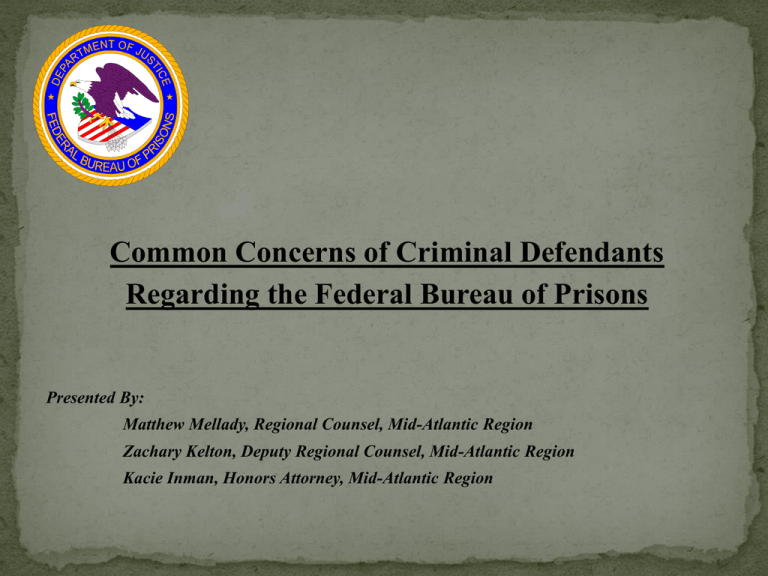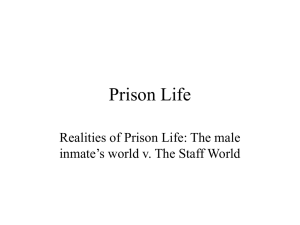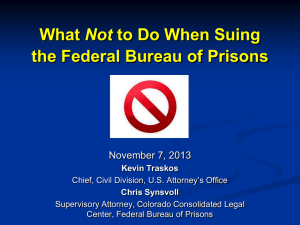Common Concerns of Federal Defendants with Federal BOP (PPT)
advertisement

Common Concerns of Criminal Defendants Regarding the Federal Bureau of Prisons Presented By: Matthew Mellady, Regional Counsel, Mid-Atlantic Region Zachary Kelton, Deputy Regional Counsel, Mid-Atlantic Region Kacie Inman, Honors Attorney, Mid-Atlantic Region Objectives: • • • • • • • • • Overview of Federal Bureau of Prisons Mental Health/Competency Evaluations Initial Designations / Judicial Recommendations Sentence Computation Attorney-Client Communications Inmate Financial Responsibility Program (IFRP) Residential Drug Abuse Treatment Program (RDAP) Residential Re-Entry Centers (Halfway Houses) Q&A The Bureau of Prisons, under the direction of the Attorney General, shall – Have charge of management and regulation of all Federal penal and correctional institutions Provide suitable quarters and for the safekeeping, care and subsistence of persons charged, convicted of federal offenses Provide for the protection, instruction and discipline of persons charged with or convicted of federal offenses It is the mission of the Federal Bureau of Prisons to protect society by confining offenders in the controlled environments of prisons and community-based facilities that are safe, humane, cost-efficient, and appropriately secure, and that provide work and other self-improvement opportunities to assist offenders in becoming lawabiding citizens. Matthew Mellady, Regional Counsel, 301-317-3120 Zachary Kelton, Deputy Regional Counsel, 301-317-3113 Diana Lee, Senior Counsel, 301-317-3128 Cristina Hillyer, Attorney-Advisor, 301-317-3121 Kacie Inman, Honors Attorney, 301-317-3124 Website: www.bop.gov BOP Program Statements Legal Resource Guide Numbers & Addresses for BOP Offices/Facilities 118 institutions Total Federal Inmate Population: 211,150 Sentenced Inmate Population: 198,643 Average Inmate Age: 40 Inmate Breakdown by Security Level: High Security: 11% Medium Security: 29% Low Security: 40% Minimum Security: 17% Unclassified or Pending: 3% Inmate Breakdown by Sentence Imposed: Death: 57 (<.01%) Life Imprisonment: 6,133 (3%) More Than 20 Years: 20,089 (10%) 15-20 Years: 18,874 (9%) 10-15 Years: 40,818 (20%) 5-10 Years: 57,689 (29%) 3-5 Years: 28,459 (14%) 1-3 Years: 23,751 (12%) Less Than 1 Year: 4,973 (3%) 18 U.S.C. §§ 4241 et seq. Determination of mental competency to stand trial Determination of the existence of insanity at the time of the offense • • • Outpatient evaluations If detained – BOP has specially trained forensic psychologists On bond – community evaluation • 18 U.S.C. § 3006A(e) – services other than counsel • DOJ FEW (fees and expenses for witnesses) funds • motion/draft order language: • Psychiatric or psychological examination • “appropriate facility” Program Statement 5100.08 Inmate Security Designation and Custody Classification USMS electronically sends designation packet to the BOP’s Designation and Sentence Computation Center (DSCC). The packet includes, at a minimum, the USMS Form 129, J&C, SOR and PSR. Judicial recommendations in the J&C are a factor considered during the designation process Classification is necessary to place each inmate in the most appropriate security level institution that also meets his/her program needs and is consistent with the Bureau’s mission to protect society. BOP facilities are classified into Minimum, Low, Medium, High, & Administrative facilities based upon the level of security and staff supervision the institution is able to provide. Initial security designation data is entered based upon information contained within the PSR. Detainers/Pending Charges Pre-Commitment Status (VS = minus 3 points) Judicial Recommendations Violence History Escape History Education Level Months to Release Offense Severity Criminal History Score (derived from the Criminal History Points in final judgment & SOR. If not in either document, BOP uses the points assessed by USPO in PSR.) An inmate’s security point score is used to determine a security level for an inmate (i.e., minimum, low, medium, high, administrative). DSCC then uses the medical/mental health calculator to establish a care level. If significant medical or mental health issues are presented, the Office of Medical Designation & Transportation (OMDT) makes the designation. In deciding where to designate an inmate, designators consider the custody classification level and: Inmate’s care level Inmate’s release residence Inmate’s programming needs Population levels at appropriate institutions Recommendations of the sentencing court Central Inmate Monitoring (CIM) issues Increased security measures to ensure protection of victims/witnesses and the public Upon completion of the designation, DSCC staff notifies USMS of designation, and arrangements are made for transportation of the inmate to the designated institution. Most initial designations are made within seven days of receipt of the packet. BOP makes every effort to comply with judicial recommendations so long as the recommendation does not conflict with BOP policy and/or sound correctional management. Nationwide, judicial recommendations are followed approximately 70% of the time. Program Statement 5880.28 (Post-CCCA) Program Statement 5880.30 (Pre-CCCA) Program Statement 5880.33 (District of Columbia) ○ Sentencing Court Determines: • The length of the prison sentence; • How sentence runs in relation to other sentences, e.g., concurrent, consecutive, etc. - 18 U.S.C. § 3584(a) ○ BOP Determines: • • • • • Date of sentence commencement - 18 U.S.C. § 3585(a) Prior custody credit - 18 U.S.C. § 3585(b) Projected good conduct time - 18 U.S.C. § 3624(b) Projected release date - 18 U.S.C. § 3624(a) Place of incarceration - 18 U.S.C. § 3621(b) 1. When does the sentence commence? •18 U.S.C. § 3585(a) - when defendant is received into custody at (or awaiting transport to) “facility at which sentence is to be served.” 2. Prior Custody Credit •Calculated by the BOP (United States v. Wilson, 503 U.S. 329, 112 S.Ct. 1351 (1992)) •18 U.S.C. § 3585(b): Credit given for time in “official detention” • (b)(1) as a result of the current offense; or • (b)(2) any other offense for which defendant was arrested AFTER commission of current offense which has not been credited towards another sentence Good Conduct Time (GCT) 18 U.S.C. § 3624(b) Available only for sentences longer than 1 year. BOP awards 54 days GCT at end of each year served Correspondence: 28 C.F.R. § 540.10 et seq. Program Statement 5265.14 Limitations (28 C.F.R. § 543.14) Program Statement 1315.07, Inmate Legal Activities Visiting: 28 C.F.R. §540.40 (general) 28 C.F.R. § 543.12, et seq. (attorneys) 28 C.F.R. § 551.117 (pretrial inmates) Program Statement 5267.08 Program Statement 1315.07, Inmate Legal Activities Telephone calls: 28 C.F.R. § 540.100 et seq. (general rules) 28 C.F.R. § 540.102 (monitoring) 28 C.F.R. § 540.103 (attorney calls – unmonitored) 28 C.F.R. § 551.117 (c) (pretrial inmates) Program Statement 5264.08 Program Statement 1315.07, Inmate Legal Activities Paralegals, clerks and other legal assistants (28 C.F.R. § 543.16): Same status as attorneys for visiting and correspondence Attorney must certify: assistant able to perform role attorney will supervise acceptance of responsibility for conduct Program Statement 5380.08 Inmate Financial Responsibility Program When an inmate has financial obligations ordered by the Court (assessments, restitution, fines, court costs), his Unit Team will review those obligations and develop a financial plan with the inmate to pay them. The inmate is responsible for making satisfactory progress in meeting his financial obligations. Unit staff and the inmate will determine an appropriate minimum amount for IFRP payments. In determining the appropriate expectation for payments, the Unit Team and inmate will look at the total funds deposited in the inmate’s trust fund account for the previous six months, minus any amounts paid towards IFRP obligations and excluding $450.00 which is anticipated to be used for the inmate telephone system. Ordinarily, the minimum payment would be $25.00 per quarter, or 50% of pay for UNICOR workers. Participation in the IFRP program is voluntary. However, inmates with active obligations who refuse to make payments as established by their financial plan will be ineligible for certain benefits. For example, The inmate will not be eligible for a non-medical or non-emergency furlough; The inmate will not receive pay over maintenance pay; The inmate will not be assigned to outside work details; The inmate will not be placed in UNICOR; and The inmate will be quartered in the lowest housing status. Total Number of Payable Obligations: 67,086 Total Number of Active IFRP Contracts: 56,047 Total Number of Contracts in Good Standing: 53,823 Total Number of Refusals: 870 Total IFRP Collections in FY 2012: $8,594,822.76 Program Statement 5330.11, Psychology Treatment Programs Program Statement 5331.02, Early Release Procedures Under 18 U.S.C. § 3621(e) Treatment program administered by BOP which can result in an early release of up to one year. Eligibility to participate: Sufficient time remaining on sentence (ordinarily 24 months) Documentation verifying a pattern of abuse of drugs or alcohol within the 12 months prior to arrest (can be found in PSR or medical records prior to arrest) Inmate is able to complete all phases of the program, including community transition treatment Non-violent inmates who successfully complete the RDAP may, at the discretion of the Director, be eligible for up to a one-year early release. Must have no prior or current convictions for disqualifying offenses (see PS 5162.04, Categorization of Offenses) Satisfactory behavior in prison; and Successful completion of all 3 components of RDAP Inmates with disqualifying convictions but documented substance abuse disorders may still participate in the program, but will not receive an early release benefit. § 550.55(a)(1)(i) - Committed federal offense before 11/1/1987 § 550.55(a)(1)(ii) - Committed D.C. offense before 8/5/2000 § 550.55(b)(1) - ICE Detainee § 550.55(b)(2) - Pretrial Inmate § 550.55(b)(3) - Contractual Boarder (e.g., state or military inmates) § 550.55(b)(7) - Previously received early release under 3621(e) PS 5331.02, § 7(a) - Has a detainer that will prohibit completion of the community treatment component of the RDAP Program Statement 7310.04 Community Corrections Center (CCC) Utilization and Transfer Procedures ○ Residential Reentry Centers (RRC) • 18 U.S.C. § 3621(b): “Any order, recommendation, or request by a sentencing court that a convicted person serve a term of imprisonment in a community corrections facility shall have no binding effect on the authority of the Bureau under this section to determine or change the place of imprisonment of that person.” • 18 U.S.C. § 3624(c)(1): “The Director of the Bureau shall, to the extent practicable, ensure that a prisoner serving a term of imprisonment spends a portion of the final months of that term (not to exceed 12 months), under conditions that will afford that prisoner a reasonable opportunity to adjust to and prepare for the reentry of that prisoner into the community. Such conditions may include a community correctional facility.” ○ Home Confinement (HC) - 18 U.S.C. § 3624(c)(2) • “The authority under this subsection may be used to place a prisoner in home confinement for the shorter of 10 percent of the term of imprisonment of that prisoner or 6 months.” ○ Inmate will receive a review for placement in an RRC or home confinement pursuant to the statutory guidelines provided in 18 U.S.C. § 3621(b), including: ○ ○ ○ ○ ○ The resources of the facility contemplated; The nature and circumstances of the offense; The history and characteristics of the offender; Any relevant statement by the court that imposed the sentence; and Any other pertinent policies or considerations. The average length of an RRC placement is 131 days. Questions?





